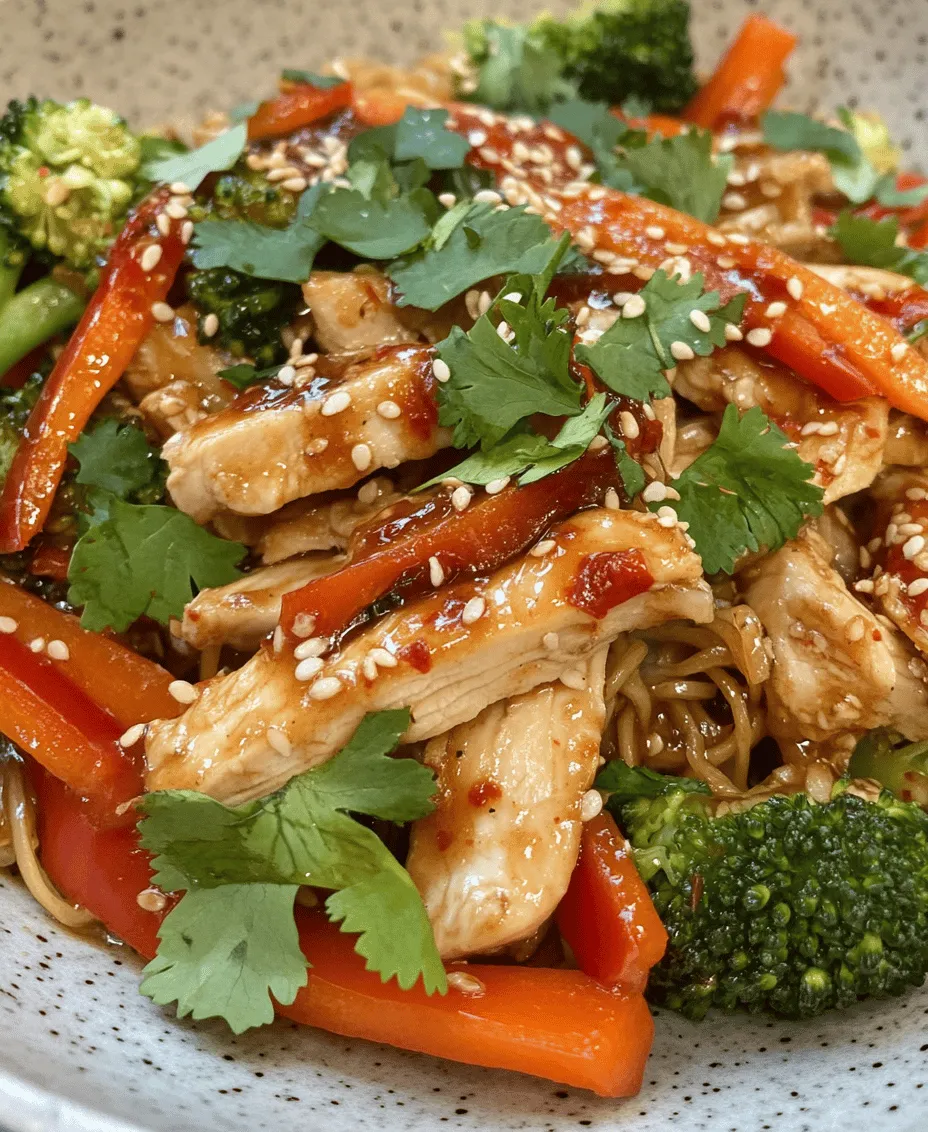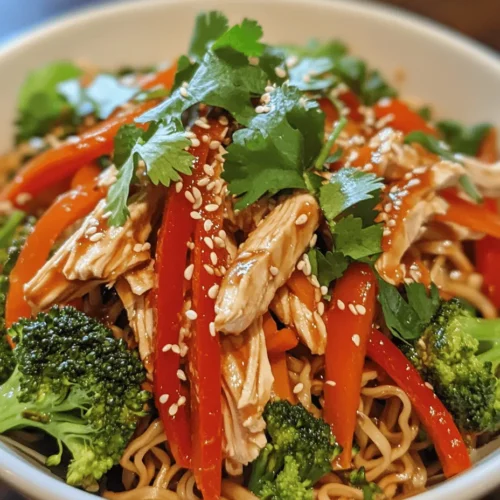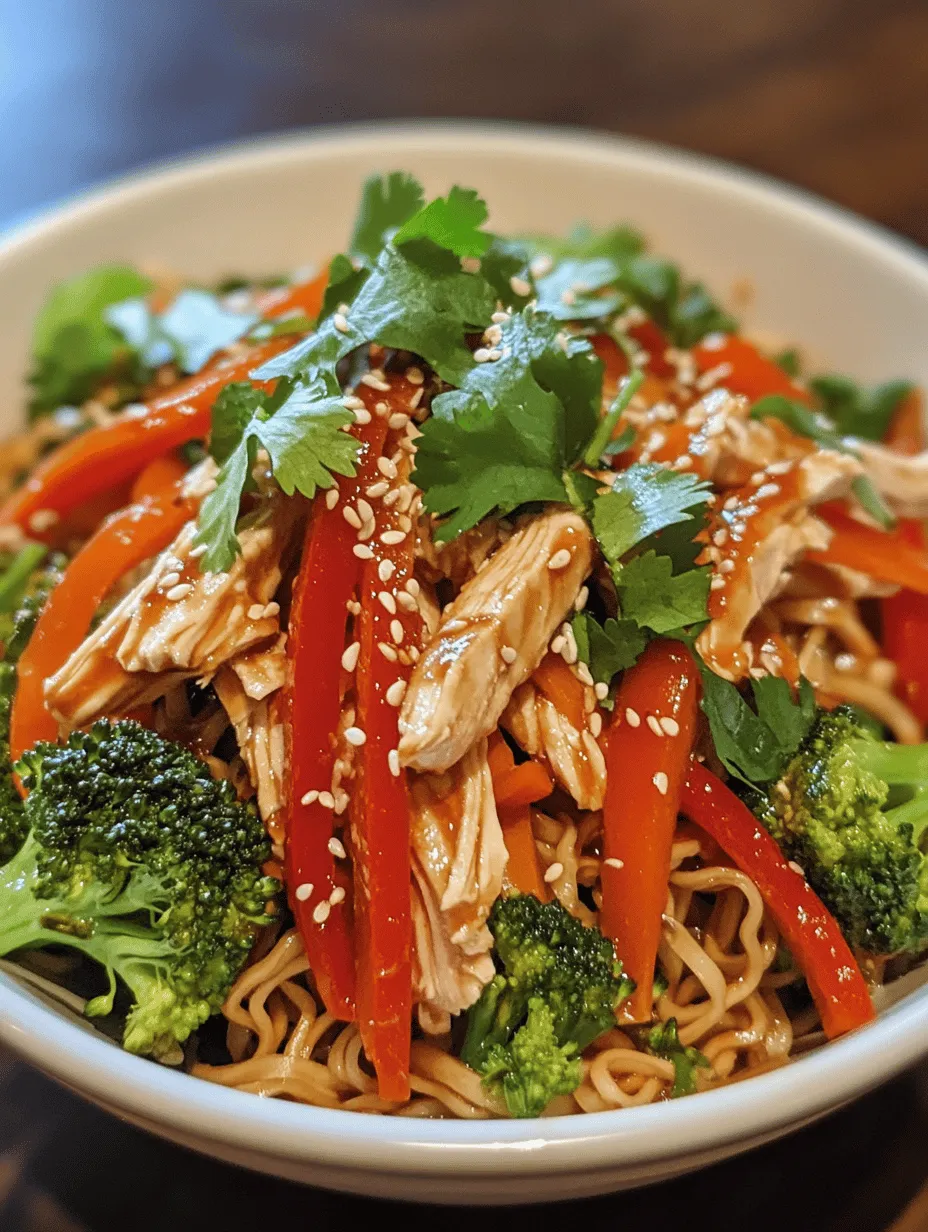In the realm of quick and flavorful meals, Spicy Chicken Ramen Stir Fry emerges as a vibrant, satisfying dish that beautifully marries tender chicken, crisp vegetables, and hearty ramen noodles. This recipe is not just a delight for the taste buds; it is a visual feast that appeals to all ages, making it an ideal choice for family dinners or casual gatherings. With its dynamic interplay of textures and flavors, this stir fry offers the perfect opportunity to bring a taste of Asian cuisine into your home kitchen in just about 30 minutes.
Understanding the Appeal of Ramen Stir Fry
Exploration of Ramen’s Cultural Significance
Ramen is more than just a popular noodle dish; it is a cultural icon deeply embedded in Asian cuisine, particularly in Japan. The historical roots of ramen can be traced back to China, where wheat noodles were introduced in the late 19th century. These noodles underwent a significant transformation in Japan, evolving into the beloved dish we know today. Initially, ramen was a simple meal enjoyed by the working class, but over the decades, it has transformed into a gourmet experience, showcased in ramen shops across the globe.
The evolution of ramen has seen it transcend its humble beginnings, becoming a global favorite. In recent years, ramen has taken on new forms and flavors, inspiring chefs and home cooks alike to experiment with various ingredients. This versatility has made ramen a canvas for culinary creativity, resulting in a myriad of variations, including vegetarian, spicy, and fusion styles. Ramen’s ability to adapt and evolve has contributed to its enduring popularity, making it a staple in many households.
The Rise of Stir Fry in Home Cooking
Stir frying is a cooking technique that not only embodies the essence of Asian cuisine but also aligns perfectly with the fast-paced lifestyle of today. The benefits of stir frying are twofold: it allows for quick cooking while preserving the nutritional value of the ingredients. The high heat of the wok or skillet ensures that food cooks rapidly, sealing in flavors and maintaining a crisp texture, particularly for vegetables.
The stir fry method enhances the overall flavor and texture of the dish. By cooking ingredients at high temperatures and in quick succession, the natural sugars in vegetables caramelize, creating a delightful contrast to the savory notes of the chicken and sauces. The result is a dish that is not only delicious but also visually appealing, with vibrant colors and a variety of textures. This technique has made stir fry an increasingly popular choice for home cooking, allowing anyone to whip up a restaurant-quality meal in the comfort of their kitchen.
Ingredients Breakdown for Spicy Chicken Ramen Stir Fry
Essential Ingredients for the Dish
To create an authentic Spicy Chicken Ramen Stir Fry, it is essential to understand the key ingredients that contribute to its unique flavor profile and texture.
Overview of Ramen Noodles
Ramen noodles are the backbone of this dish, providing a chewy and satisfying base. There are various types of ramen noodles available, including fresh, dried, and instant varieties. For this recipe, fresh or dried ramen noodles are ideal, as they offer better texture compared to instant noodles. Fresh ramen noodles cook quickly and retain their bite, while dried noodles require slightly longer cooking times but still yield excellent results.
When cooking ramen, it is crucial to follow the package instructions to achieve the perfect texture. Generally, ramen noodles should be boiled in salted water until they are al dente, ensuring they remain firm and do not turn mushy. Drain them promptly and rinse under cold water to stop the cooking process and prevent clumping.
Chicken Thighs vs. Other Proteins
Choosing the right protein is vital for a successful ramen stir fry. While chicken breasts are often the go-to choice for many recipes, chicken thighs are highly recommended for this dish. Chicken thighs are juicier and more flavorful than their breast counterparts, providing a richer taste that complements the robust flavors of the stir fry. Their higher fat content also helps keep the meat tender and moist during cooking, ensuring a satisfying bite in every spoonful.
If you prefer alternative proteins, consider using shrimp, beef, or tofu as substitutes. Each option brings its unique flavor and texture, allowing for customization based on dietary preferences or availability.
The Role of Fresh Vegetables
Fresh vegetables play a crucial role in enhancing both the taste and nutritional value of Spicy Chicken Ramen Stir Fry. Common choices include bell peppers, snap peas, broccoli, and carrots. These vegetables not only add a crisp texture but also contribute vibrant colors, making the dish visually appealing.
Incorporating a variety of vegetables ensures a balanced meal rich in vitamins and minerals. Aim for a mix of colors and textures to create a more exciting dish. For instance, bright red bell peppers add sweetness and crunch, while green snap peas provide a fresh, crisp bite. Feel free to experiment with seasonal vegetables or whatever you have on hand to make this dish your own.
Condiments and Seasonings
The flavor of Spicy Chicken Ramen Stir Fry is largely derived from the combination of sauces and seasonings used in the recipe. Key condiments include soy sauce, oyster sauce, and sesame oil, each contributing distinct flavors to the dish.
– Soy Sauce: A staple in Asian cuisine, soy sauce provides a salty umami flavor that enhances the overall taste of the stir fry. Opt for low-sodium soy sauce if you’re concerned about salt intake, as it will still impart the necessary depth of flavor without overwhelming the dish.
– Oyster Sauce: This rich and slightly sweet sauce adds complexity and a hint of sweetness to the stir fry. It is a perfect complement to the savory chicken and vegetables, creating a well-rounded flavor profile.
– Sesame Oil: A drizzle of toasted sesame oil at the end of cooking adds a fragrant, nutty aroma that elevates the dish. Use it sparingly, as a little goes a long way in terms of flavor.
– Adjusting Spice Levels with Sriracha: For those who enjoy a kick of heat, sriracha is an excellent addition to the sauce. You can adjust the amount of sriracha to suit your spice tolerance, making it easy to customize the dish for everyone at the table.
Step-by-Step Preparation of Spicy Chicken Ramen Stir Fry
With your ingredients prepped and ready, it’s time to dive into the cooking process. The following step-by-step instructions will guide you through making a delicious Spicy Chicken Ramen Stir Fry that is sure to impress.
Cooking the Ramen Noodles
1. Boil Water: Begin by bringing a large pot of water to a boil. Add a generous pinch of salt to the water, which will season the noodles as they cook.
2. Add Ramen Noodles: Once the water is boiling, add the ramen noodles and cook according to the package instructions. Fresh noodles typically take around 3-4 minutes, while dried noodles may take slightly longer.
3. Stir Occasionally: To prevent the noodles from sticking, stir them occasionally as they cook. This will help them cook evenly and maintain their texture.
4. Check for Doneness: Taste the noodles to ensure they are al dente—cooked but still firm to the bite. Overcooking will result in mushy noodles that do not hold up well in the stir fry.
5. Drain and Rinse: Once the noodles are cooked, drain them in a colander and rinse under cold water. This stops the cooking process and removes excess starch, which helps prevent clumping.
6. Set Aside: Toss the rinsed noodles with a small drizzle of sesame oil to coat them lightly and set them aside while you prepare the stir fry.
Making the Flavorful Sauce
1. Combine Sauces: In a small bowl, combine the soy sauce, oyster sauce, and sriracha. Start with a small amount of sriracha (about 1 teaspoon) and adjust according to your spice preference. Whisk the ingredients together until well blended.
2. Taste and Adjust: Before adding the sauce to the stir fry, taste it to ensure the flavors are balanced. If you desire more heat, add extra sriracha. For a touch more sweetness, consider adding a teaspoon of sugar or honey.
3. Prepare for Cooking: Gather all your prepped ingredients, including the cooked ramen noodles, chicken, and vegetables, before you start cooking. Stir frying is a quick process, and having everything ready to go will ensure smooth cooking.
Following these steps will set the stage for creating an unforgettable Spicy Chicken Ramen Stir Fry that is both delicious and visually appealing. With the noodles cooked to perfection and a flavorful sauce ready to bring the dish together, you are well on your way to enjoying a delightful meal that captures the essence of Asian cuisine. Stay tuned for the next part, where we will dive into the cooking process and finish bringing this vibrant dish to life.

Sautéing the Chicken
Achieving the perfect sear on chicken is crucial for flavor development in your Spicy Chicken Ramen Stir Fry. The process begins with selecting the right cut of chicken, typically boneless, skinless chicken thighs or breasts. Thighs are generally juicier and more flavorful, making them a great choice for stir-frying.
Best Practices for Browning Chicken
1. Preheat Your Pan: Start by heating your wok or large skillet over medium-high heat. A hot surface is essential for searing as it creates a caramelized crust on the chicken, locking in moisture and flavor.
2. Use the Right Oil: Opt for high smoke point oils like vegetable oil, canola oil, or peanut oil. These oils can withstand the high temperatures required for stir-frying without burning.
3. Don’t Overcrowd the Pan: If you add too much chicken at once, the temperature of the pan will drop, causing the chicken to steam rather than sear. Work in batches if necessary, ensuring each piece has enough space to cook evenly.
4. Pat Dry: Before cooking, pat the chicken dry with paper towels. Removing excess moisture helps achieve that golden-brown sear you desire.
5. Timing is Key: Cook the chicken for about 4-5 minutes per side, depending on thickness. It should be golden brown and cooked through to an internal temperature of 165°F (75°C). Remove it from the pan and set it aside while you stir-fry the vegetables.
Importance of Cooking Time and Temperature
Maintaining the right temperature throughout the cooking process is critical. If the pan isn’t hot enough, your chicken will release moisture and fail to develop that sought-after crust. Conversely, if the heat is too high, you risk burning the chicken before it’s fully cooked. A medium-high heat strikes a perfect balance, allowing the chicken to sear effectively while ensuring it doesn’t dry out.
Stir-Frying the Vegetables
Once your chicken is perfectly sautéed, it’s time to turn your attention to the vegetables. This step is where you can infuse the dish with vibrant colors and crisp textures.
Techniques for Keeping Vegetables Crisp While Cooking
1. Cut Evenly: Chop your vegetables into uniform sizes to ensure they cook at the same rate. This not only enhances the presentation but also improves the overall texture of the stir fry.
2. Add in Stages: Start with harder vegetables like carrots and bell peppers, which take longer to cook. Follow with quicker-cooking greens like bok choy or snap peas, which only need a couple of minutes to retain their crunch.
3. High Heat and Quick Cooking: As with the chicken, make sure your pan is hot before adding the vegetables. Stir-fry them for just 2-4 minutes, stirring constantly, to keep them crisp.
The Significance of Garlic and Ginger in Enhancing Flavor Profiles
Garlic and ginger are staples in Asian cooking, known for their robust flavors and aromatic properties. As you add your vegetables to the pan, include minced garlic and ginger to the mix. Sauté them for about 30 seconds before adding the vegetables; this will release their essential oils and create a fragrant base for your stir fry. The warmth of ginger adds a slight spiciness, while garlic enhances the overall depth of flavor.
Bringing It All Together
Now that your chicken and vegetables are ready, it’s time to unite them for the ultimate flavor explosion.
Combining Ingredients: Ensuring Even Flavor Distribution
Return the browned chicken to the pan with the vegetables. Pour in your prepared sauce—typically a mix of soy sauce, sriracha, and sesame oil—and toss everything together using a spatula or tongs. This ensures that each ingredient is coated in the sauce, allowing for a harmonious blend of flavors.
Tips for Achieving a Harmonious Mix of Textures
To achieve that delightful contrast in textures, consider adding a handful of cooked ramen noodles at this stage. Gently toss everything together, ensuring the noodles are fully integrated without breaking them apart. The noodles will soak up the sauce while providing a chewy texture that complements the tender chicken and crisp vegetables.
Garnishing and Serving Suggestions
Creating a visually appealing dish is almost as important as the flavor itself. A well-plated meal not only tempts the taste buds but also elevates the dining experience.
The Role of Garnishes: How They Enhance Flavor and Presentation
Garnishes play a significant role in both flavor enhancement and visual appeal. Consider using:
– Chopped Green Onions: Sprinkle them on top for a fresh, sharp bite.
– Sesame Seeds: Toasted sesame seeds add a nutty flavor and a delightful crunch.
– Chili Flakes or Slices: For those who enjoy extra heat, these can intensify the spiciness of the dish.
Creative Ideas for Plating and Serving
For a beautiful presentation, serve your Spicy Chicken Ramen Stir Fry in a deep bowl. Layer the noodles first, followed by the chicken and vegetable mixture. Top it off with your garnishes, and serve with lime wedges on the side for a burst of freshness. This not only adds a pop of color but also allows diners to customize their experience with a squeeze of lime.
Pairing Options for a Complete Meal
To elevate your dining experience, consider pairing your stir fry with complementary side dishes and beverages.
Suggested Side Dishes and Beverages to Complement the Stir Fry
– Spring Rolls: These crispy appetizers are a classic pairing, providing a crunchy contrast to the soft noodles and tender chicken.
– Miso Soup: A warm miso soup can serve as a soothing starter, balancing the heat of the stir fry with its umami flavors.
– Green Tea: A refreshing green tea or jasmine tea will cleanse your palate and enhance the overall meal experience.
Cultural Context of Meal Pairings in Asian Cuisine
In Asian cuisine, the concept of balance is paramount. Meals are often designed to include a variety of flavors, textures, and temperatures. Pairing your Spicy Chicken Ramen Stir Fry with lighter dishes like spring rolls or soup not only provides contrast but also creates a well-rounded meal that respects traditional culinary practices.
Nutritional Benefits of Spicy Chicken Ramen Stir Fry
Now that you’ve prepared a delicious dish, let’s take a moment to analyze the health aspects of this recipe.
Nutritional Breakdown of the Main Ingredients
– Chicken: A great source of lean protein, chicken is essential for muscle growth and repair. It also contains vitamins such as B6 and niacin, which support metabolism.
– Vegetables: The colorful array of vegetables adds essential vitamins, minerals, and antioxidants. For instance, bell peppers are high in vitamin C, while leafy greens offer iron and calcium.
– Ramen Noodles: While traditional ramen noodles can be high in carbs, they provide energy. Opting for whole grain or vegetable-based noodles can enhance the nutritional profile.
Benefits of Consuming Homemade Stir Fry Versus Takeout
Homemade stir fry allows for greater control over ingredients and portion sizes, making it easier to create a healthier meal. Takeout often contains hidden sugars, excess sodium, and unhealthy fats. By preparing this dish at home, you can tailor it to your dietary preferences while ensuring a fresher and more nutritious meal.
Adapting the Recipe for Dietary Preferences
Every cook has different dietary needs, and this recipe can be easily adapted.
Substitutions for Common Dietary Restrictions
– Gluten-Free: Substitute traditional ramen with gluten-free noodles made from rice or buckwheat. Ensure that your soy sauce is gluten-free as well.
– Vegetarian: Replace chicken with tofu or tempeh, marinating them in the same sauce for flavor. You can also add more vegetables to increase the volume and nutrition of the dish.
Balancing Flavors for Different Dietary Needs
For those watching their sodium intake, consider using low-sodium soy sauce or coconut aminos as a substitute. Additionally, if you prefer a milder dish, reduce the amount of sriracha or substitute it with a mild chili sauce.
Conclusion: Embracing the Joy of Cooking with Spicy Chicken Ramen Stir Fry
Spicy Chicken Ramen Stir Fry is more than just a meal; it’s an experience that brings together the joy of cooking and the satisfaction of eating. This recipe embodies the essence of home-cooked meals—quick, delicious, and adaptable to personal tastes. By mastering this dish, you not only gain a stellar recipe but also a deeper appreciation for the art of stir-frying and the flavors of Asian cuisine. Enjoy the vibrant taste and the warmth of this dish as it becomes a staple in your kitchen repertoire. Whether you’re cooking for yourself, family, or friends, this stir fry promises to delight and satisfy, showcasing the beauty of homemade cooking.



